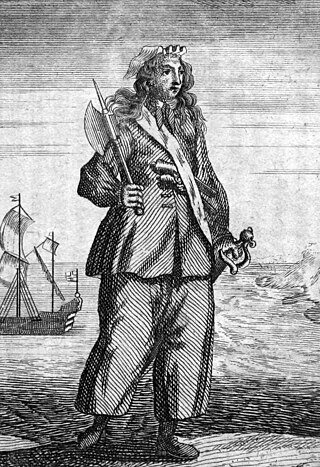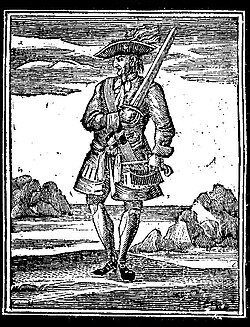
The earliest arrival of people in the islands now known as the Bahamas was in the first millennium AD. The first inhabitants of the islands were the Lucayans, an Arawakan language-speaking Taino people, who arrived between about 500 and 800 AD from other islands of the Caribbean.

John Rackham, commonly known as Calico Jack, was an English pirate captain operating in the Bahamas and in Cuba during the early 18th century. His nickname was derived from the calico clothing that he wore, while Jack is a nickname for "John".

Mary Read, was an English pirate. She and Anne Bonny were among the few female pirates during the "Golden Age of Piracy".
Benjamin Hornigold was an English pirate towards the end of the Golden Age of Piracy.

Anne Bonny was a pirate who served under John "Calico Jack" Rackham. Amongst the few recorded female pirates in history, she has become one of the most recognized pirates of the Golden Age of Piracy as well as in the history of piracy in general.

The Golden Age of Piracy is a common designation for the period between the 1650s and the 1730s, when maritime piracy was a significant factor in the histories of the North Atlantic and Indian Oceans.

Charles Vane was an English pirate who operated in the Bahamas during the end of the Golden Age of Piracy.
Henry Jennings was an English privateer-turned-pirate. Jennings's first recorded act of piracy took place in early 1716 when, with three vessels and 150–300 men, Jennings's fleet ambushed the Spanish salvage camp from the 1715 Treasure Fleet. After the Florida raid, Jennings and his crew also linked up with Benjamin Hornigold's "three sets of pirates" from New Providence Island.
See also 1717 in piracy, 1719 in piracy, and Timeline of piracy.
See also 1719 in piracy, 1721 in piracy and Timeline of piracy.
True Caribbean Pirates is a documentary that aired on the History Channel in 2006.

The Atlantic World refers to the period from the European colonization of the Americas, around 1492, to the early nineteenth century. Piracy became prevalent in this era because of the difficulty of policy in this vast area, the limited state control over many parts of the coast, and the competition between European powers. The best-known pirates of this era are the Golden Age Pirates who roamed the seas off North America, Africa, and the Caribbean coasts.

The Republic of Pirates was the base and stronghold of a loose confederacy run by privateers-turned-pirates in Nassau on New Providence island in the Bahamas during the Golden Age of Piracy for about twelve years from 1706 until 1718. While it was not a republic in a formal sense, it was governed by an informal pirate code, which dictated that the crews of the Republic would vote on the leadership of their ships and treat other pirate crews with civility. The term comes from Colin Woodard's book of the same name.
Leigh Ashworth was a pirate and privateer operating in the Caribbean in the early 1700s.

The Flying Gang was an 18th-century group of pirates who established themselves in Nassau, New Providence in the Bahamas after the destruction of Port Royal in Jamaica. The gang consisted of the most notorious and cunning pirates of the time, and they terrorized and pillaged the Caribbean until the Royal Navy and infighting brought them to justice. They achieved great fame and wealth by raiding salvagers attempting to recover gold from the sunken Spanish treasure fleet. They established their own codes and governed themselves independent from any of the colonial powers of the time. Nassau was deemed the Republic of Pirates as it attracted many former privateers looking for work to its shores. The Governor of Bermuda stated that there were over 1,000 pirates in Nassau at that time and that they outnumbered the mere hundred inhabitants in the town.
Jean Bonadvis was a French pirate active in the Caribbean. He is best known for his involvement with Benjamin Hornigold and "Calico Jack" Rackham.

Robert Deal was a pirate active in the Caribbean. He is best known for his association with Charles Vane.
Joseph Thompson was a pirate from Trinidad, Cuba, and was active in the Caribbean. He is primarily known for a single incident involving grenades.

Jonathan Barnet was an English privateer in the Caribbean, best known for capturing pirates Calico Jack, Anne Bonny, and Mary Read. The Assembly of the Colony of Jamaica gave him a financial reward and a large estate in the parish of St James, where enslaved Africans worked.

The Proclamation for Suppressing of Pirates was a royal proclamation issued by George I of Great Britain on 5 September 1717. It promised a pardon for acts of piracy committed before the following 5 January to those pirates who surrendered themselves to the correct authority before a deadline. Originally, the surrender had to occur on or before 5 September 1718; this was later extended by a second proclamation to 1 July 1719.












